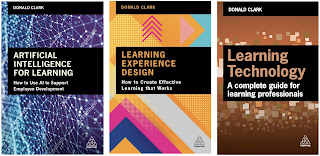In learning AI changes life and work, and by consequence, what, whenever, when and how we learn. AI promises to deliver adaptive and personalised learning on any topic at low cost freeing education from expensive scarcity. This is because it increases the efficacy, not only of content creation but, more importantly delivery. We see a glimpse of this with Duolingo, now an AI company with a highly effective personalised learning system, that is free. They have now expanded into Mathematics.
They used to say that information wants to be free. A far better mantra is to say that education wants to be free. First, free from the tyranny of time, having fixed lengths of time to get to competence, fixed timetables, course times and so on. Secondly, free learners from the tyranny of place, having to be somewhere specific, like a lecture hall or classroom.
I explored this in my book ‘AI for Learning’. Accelerating learning, making it readily available, along with semantic search and the many other gifts that AI will bring, should make organisational development that much easier, cheaper, faster and better. This has been the promise of most technology and if we look at the past, technology has, on the whole, delivered.
Generative AI
Generative AI is still in its infancy, yet achieved instant global awareness with ChatGPT. That impact came from the realisation, often from the first output to the first question you asked, that this has huge potential. It put AI into the hands of millions, made it real. There was the expected negativity, largely born of fear, as is usually the case with new technology in learning, but that quickly gave way to wonder, lots of creative uses and speculation about the future.
It is important not to see generative AI as the only way AI has and will impact L&D. My books ‘AI for Learning’ , 'Learning Experience Design' and ‘Learning technologies’ go across the entire learning journey, showing how AI has already embedded itself into almost everything we do online. In that sense it has been here for at least 20 years in search, in UI, text to speech, speech to text (increasing accessibility), also in learning support, content creation, recommended learning pathways, adaptive, personalised learning, assessment and spaced practice.
Prompt Engineering
What ChatGPT does is allow you to use the tool to teach and learn. Once you have mastered ‘prompt engineering’, knowing how to construct the right input, understanding that ChatGPT is a dialogue system not just a producer of monolithic pieces of text, you can output wonderful things. This is a new skill for learning designers and generative AI allows all sorts of complex prompting using iterations, logic and parameters that improve the output.
It allows you to improve up-front design, get the juices going with stakeholders, producing objectives, likely competencies and skills, syllabi, even titles for your learning initiatives. To create content one can prompt for full content with the right level of detail and nuance, summaries, images, all in different styles and voices, suitable for different audiences. You can create assessments and assignments with full rubrics for marking, also learning activities for discussions, scenarios and role playing. Beyond this you can prompt for emails, social media content and marketing. We have put together a list of 100 prompt ideas for learning professionals to allow learning professionals to widen their perspective on this technology which we will be using in planned talks and workshops.
Remember that this is only the start of AI tools that will dramatically improve productivity for teachers, learning designers and learners.

No comments:
Post a Comment